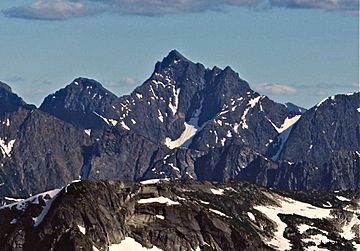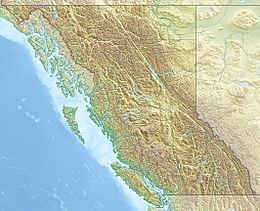Mount Payne facts for kids
Quick facts for kids Mount Payne |
|
|---|---|

Mount Payne seen from Eaton Peak
|
|
| Highest point | |
| Elevation | 2,468 m (8,097 ft) |
| Prominence | 378 m (1,240 ft) |
| Parent peak | Silvertip Mountain |
| Geography | |
| Location | British Columbia, Canada |
| Parent range | Skagit Range Canadian Cascades |
| Topo map | NTS 92 H/3 |
| Geology | |
| Mountain type | Intrusive |
| Type of rock | granitic |
| Climbing | |
| First ascent | 1950 J. Bussell, H. Genschorek, I. Kay, A. Melville, W. Sparling |
| Easiest route | Scrambling via south ridge |
Mount Payne is a mountain peak in British Columbia, Canada. It stands tall at 2,468 meters (about 8,097 feet). This impressive summit is part of the Canadian Cascades in southwestern British Columbia.
You can find Mount Payne about 27 kilometers (17 miles) southeast of Hope. It's also near Chilliwack Lake and Silvertip Mountain, which is its closest taller neighbor. After Silvertip Mountain, Mount Payne is the second-highest peak in the Hope Mountains. These mountains are a part of the larger Skagit Range.
The first time people climbed Mount Payne was in 1950. A team of five climbers, J. Bussell, H. Genschorek, I. Kay, A. Melville, and W. Sparling, made the first successful ascent.
The mountain was named in honor of Damasus Payne. He was a Benedictine monk and also a mountaineer. Sadly, he passed away in 1978 while climbing Edge Peak. Damasus Payne was known for naming other mountains, like Mount Rohr and Mount Duke. He even carried items for a special ceremony to the top of Slesse Mountain. This ceremony honored the victims of a plane crash, Trans-Canada Air Lines Flight 810. The name "Mount Payne" was officially recognized on May 7, 1984, by the Geographical Names Board of Canada.
Water from Mount Payne flows into the Sumallo River and the Klesilkwa River. The Klesilkwa River then joins the larger Skagit River.
How Mount Payne Was Formed
Mount Payne is connected to a large body of rock called the Chilliwack batholith. This rock formed deep underground about 26 to 29 million years ago. It pushed its way into the existing land after major mountain-building events. This area is part of the Pemberton Volcanic Belt. This belt is an old, worn-down chain of volcanoes. It formed because one of Earth's plates, the Farallon Plate, slowly slid under another plate. This process, called subduction, began about 29 million years ago.
During the Pleistocene period, which started over two million years ago, huge sheets of ice called glaciers covered the land. These glaciers moved forward and backward many times. As they moved, they scraped and shaped the landscape. They left behind piles of rock and debris. The "U"-shaped valleys you see in the rivers today were carved out by these glaciers.
Over millions of years, the land was also pushed up and broken along fault lines. These processes, along with the glaciers, created the tall peaks and deep valleys of the North Cascades area.
The North Cascades region has some of the most rugged and dramatic landscapes in the Cascade Range. You can see sharp, rocky peaks, long ridges, deep valleys carved by glaciers, and tall, pointed granite rocks. All these geological events from long ago created the varied landscape. They also caused big changes in elevation, which led to different climates and types of plants in this area.
Mount Payne's Weather
Most of the weather that affects Mount Payne comes from the Pacific Ocean. These weather systems, called weather fronts, travel east. When they reach the Cascade Range, the mountains force the air to rise. This process is called Orographic lift. As the air rises, it cools and drops its moisture. This means the Cascade Mountains get a lot of rain or snow.
During the winter months, especially, there is heavy snowfall. Temperatures can drop very low, sometimes below −20 °C (or −4 °F). With the wind, it can feel even colder, below −30 °C (or −22 °F). The best time to climb Mount Payne is usually from July through September. During these months, the weather is generally more favorable.



